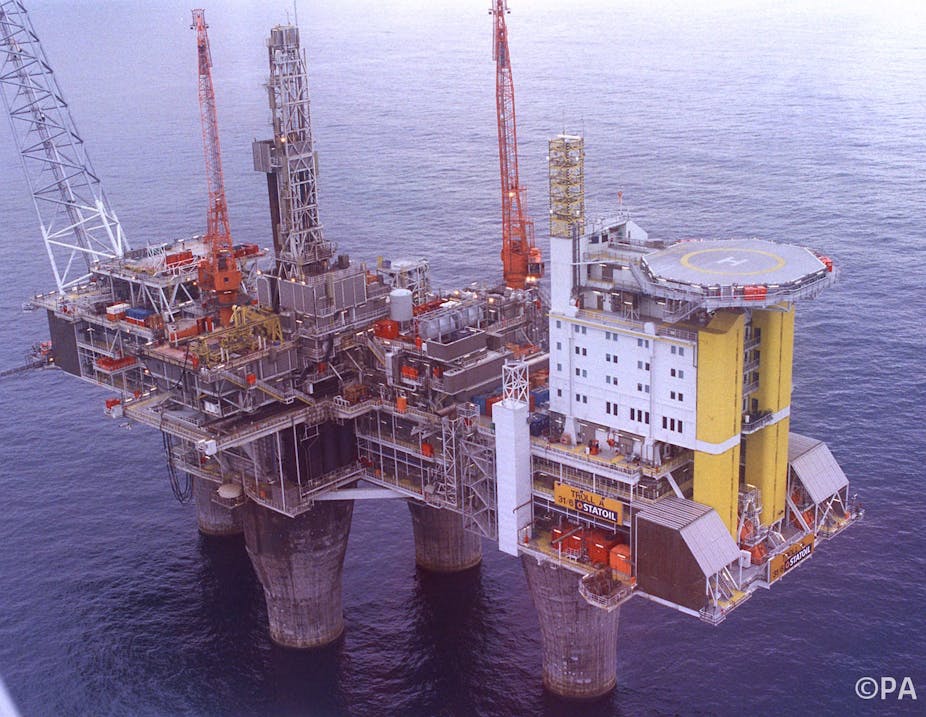For decades the UK has been accustomed to filling its coffers with the bounty from North Sea oil and gas, and the jobs and tax receipts it has brought. At one time exports helped balance the books and provided energy security on our doorstep. But production peaked at the equivalent of 4.72 million barrels per day in 1999 and the subsequent decline has in recent years accelerated, as the figures from BP’s statistical review of world energy 2013 show (below).
These days the UK is a net importer of oil and gas, and coal, accounting for £22 billion of the £59.8 billion deficit in the 2012 balance of payments. These spiralling energy costs are what led the energy minister, Ed Davey, to invite Sir Ian Wood to conduct a review of the North Sea oil industry in order to make recommendations that would ensure the maximum resource is recovered from the North Sea.

It’s worth noting that Sir Ian’s interim report, published in November, presents a figure of 41 billion barrels equivalent to the end of 2012, while the official government estimate is 42 billion, and BP’s data suggests 43.6 billion (based on BP’s conversion ratio of 1 billion cubic metres of gas = 6.6m barrels of oil). Since statistics are very important (and an error margin of a billion or two is fairly significant), the Wood Review might want to start by addressing the quality of energy reporting standards.
Sir Ian’s review team interviewed 40 companies that account for 95% of the North Sea’s oil production and examined the Department of Energy and Climate Change’s role as regulator. They found that the conflicting private interests of the many private companies extracting resources from the UK continental shelf do not necessarily line up with the UK’s sovereign interest in extracting the most resources possible. The report found DECC as regulator was “significantly under-resourced and under-powered to effectively manage” North Sea operations.
Looking at the department’s organisational structure you have to look hard to find three posts of 109 that are assigned to oil and gas – extraordinary considering the North Sea meets two-thirds of UK oil and half of UK gas demand. Only 50 personnel are assigned to the task of overseeing more than 300 UK oil and gas fields, compared with 220 personnel in Norway and 100 in The Netherlands.

Enforcing collaboration for the UK interest
A key recommendation of the report is to create a new “arms-length” regulator staffed by top industry professionals and funded by the industry itself. It would promote and facilitate collaboration between licence holders to develop resources that are currently stranded and ensure the maximum return for the UK over the next 30 years.
For example a small field may lie close to a platform owned by a third party or parties. The new regime would require the platform owner to assist the field owner to bring the field into production to the benefit of both parties and the State.
The report lists eight commitments that operating companies would be expected to make, including commitments to Maximum Economic Return for the UK, infrastructure sharing, and collaborative working with the regulator and each other.
How much more oil is there?
The interim report suggests there is the potential to extract at least 3 to 4 billion barrels of oil more than would otherwise be recovered, worth around £200 billion to the UK’s economy at today’s prices.
One of my main criticisms of the report is that it does not define what “would otherwise be recovered” actually means. I have suggested that UK Oil and Gas Reserves would produce about 4.5 billion barrels at current extraction rates, similar to proven reserves reported by DECC and BP. So “3-4 billion more” would mean around 8.5 billion barrels if Sir Ian’s recommendations were to be implemented, totalling perhaps 10 billion if we reasonably allow a further 1-2 billion more in reserves yet to be found. There will be one or two undiscovered giant fields lurking out there somewhere.
Sir Ian is explicit about where this additional oil comes from, naming enhanced oil recovery (1-6.5 billion in best case scenario), increased exploration (1-1.5 billion), better use of infrastructure (0.5-2 billion), and postponing decommissioning by five years (1 billion).
Enhanced oil recovery is necessary to retrieve the remnants of oil from mature fields. The bulk of the oil is left behind as micro-droplets either stuck to mineral grains or encased by water in rock pores. A variety of chemical methods can be used to get this oil moving up to the surface. For example, BP injects methane gas in the Magnus Field, and is proposing to inject fresh, as opposed to salt, water in their west of Shetland fields. Potentially the greatest reward comes from injecting CO2. In my opinion, the government would do well to divert its attention from carbon capture and storage to using CO2 for enhanced oil recovery.
But Sir Ian also estimates “a further 12-24 billion” barrels, without giving any reference or figures. If state regulation of the North Sea and operating practises of the companies are to be overhauled then there must be a means for measuring the effectiveness of Sir Ian’s changes. We need to know what will happen if we do nothing – and what will happen if we act boldly and quickly as he proposes.

